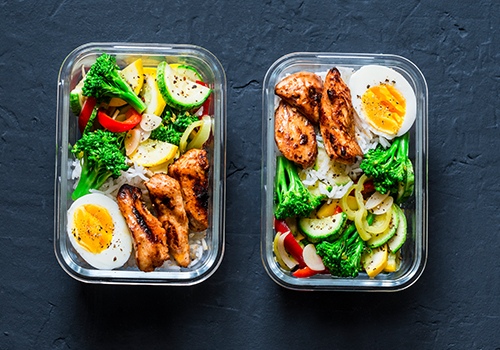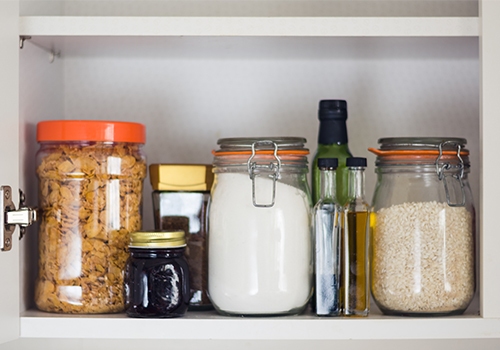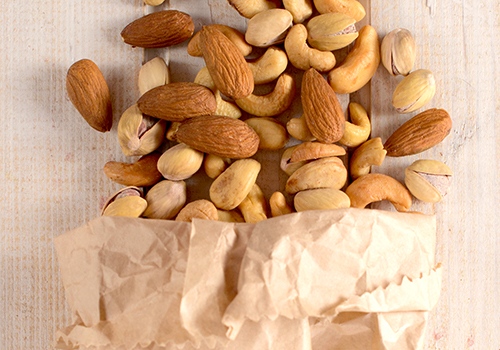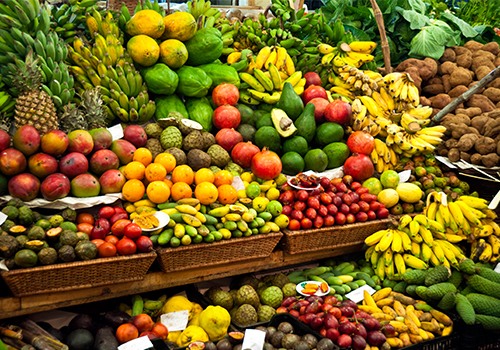When money is tight, grocery spending needs to be kept tightly under control. As a result, we sometimes tend to pick the cheapest food options—rather than the healthiest ones. But there's a fix that helps you eat well and pay less!
When you stock your pantry with healthy staples that are filling and cheap—you can make nourishing and satisfying meals for your family without blowing your budget. Planning your meals ahead and buying staple, low-cost foods like flour, sugar, rice and pasta in bulk could save you a lot of money on your weekly grocery shop.
Keep reading to see our 15 tips and start saving on your supermarket shop from today!
1. Make a grocery budget
You can’t cut back on spending without knowing how much you spend now, and how much you want to save. Every family is different.
Dig up any receipts from your recent grocery shops over the last few months and do a bit of maths to work out what your average grocery bill is. With an idea of what you’re spending, you can start to figure out what’s realistic for your family to spend—and where you can start to save or cut costs. It’s also important to factor in non-food items you might also need, like toilet paper and toothpaste. From here, you can estimate your average weekly or monthly spend and use this as a guide for future shops.

2. Create a meal plan
Going in with a plan helps you keep control of your spending. Whichever day you like to visit the grocery store, take a look at your local PAK’nSAVE’s deals to take advantage of our extra low prices.
Fresh fish and meat can often be the most expensive part of a meal, so it can help to start your meal plan by choosing proteins from the weekly specials. Then you can base your meals around those proteins. If beef mince is on special, you might choose to cook some simple slow cooker beef bolognese one evening and Mexican-style burritos on another night.
Check our our budget meal planners here.
3. Take on meal prepping
If meal planning isn’t quite enough for you, you can also introduce meal prepping to your weeknight dinner schedule. One of the most popular forms of meal prepping is cooking large batches of your favourite meals and then freezing individual portions for later. This is a great way to shop smart and save on grocery shopping — buy in bulk, then cook in bulk. Not only is this a great way to save money do you save money on food, by purchasing your ingredients in bulk when they’re on sale, you save time by having meals you can simply defrost and eat.
Want to learn to meal prep? Try out these healthy meal prep-friendly weekday lunches.

4. Stock-take before you shop
One of the easiest ways to spend less and save money on food is to simply not buy what you already have. Before you head to your nearest PAK’nSAVE, crack open the fridge and freezer and see what’s kicking around.
You probably have cuts of meat or vegetables that need to be used up. By working them into your meal plan, you’re saving money on groceries you simply don’t need, and making sure no food goes to waste. Of course, the same goes for dry goods like herbs and spices. Even though they may be cheap, repeatedly buying the same spices when you don’t need to can add up quickly.
5. Stock up on pantry essentials
Keep an eye on those deals! If you spot a pantry staple at a low price, it could be worth stocking up.
Pantry staples are items that last for a long time and can be used in a variety of recipes. Some examples include:
We tend to buy pantry staples only when we run out. However, this means you might be buying them at full price when you could get a better deal. Each week, check the deals at your local PAK’nSAVE and your own pantry stock levels. If a staple is on special and you have room to store extra, stock up now!

6. Buy in bulk, when appropriate
Buying in bulk can be cheaper. You’re paying more upfront, as you’re buying more, but ultimately getting better value.
How do you make sure you’re getting good value? When buying in bulk, work out the unit price of an item by dividing the price by the number of items in the pack. So for eggs, that’s the price divided by the number of eggs. Or for flour you might divide the price by 100 grams. Then compare your options based on the unit price. Often, buying a larger pack actually works out cheaper in the long run.
Of course, bulk buying isn’t always the best option. You’re buying more than you necessarily need, so it’s important to think about what you’re buying. Eggs, for example, can be a fantastic one to buy in bulk because they tend to last a while and can be used in a huge variety of recipes. Meanwhile, a bag of capsicums is usually cheaper (per capsicum) than a single one, but you only get to enjoy that value if you actually use all the capsicums in the bag.
7. Bulk bins or pre-packaged?
If bulk buying is the way to go, does that mean the bulk bins are cheaper? Not necessarily. Bulk bins are a great way to buy a little bit of something. For example, if you only need 100 grams of cashews for a recipe, and you’ve no other need for cashews beyond that recipe, you probably don’t need to buy a massive 400 gram bag! You’re better off buying 100 grams from a bulk bin, even though the unit price is higher.
That said, you might want to use cashews for more than one recipe, or cook the same recipe in consecutive weeks. Or you might enjoy them as a healthy snack! In this case, spending more upfront now might actually save you money in the long term. Just remember to store nuts, grains and dried fruit in airtight containers.

8. Store your food carefully
Storing your food smartly helps you minimise food waste and maximise value. Follow these tips to make your food last longer:
- Keep products like biscuits, crackers and grains in airtight containers in a cool, dark place like the pantry. This prevents them from going stale or being infested by weevils.
- Bread tends to last longer in the fridge, but can dry out. It’s still great for toast, though!
- Bread and other baked goods tend to freeze well for months, so you can definitely buy them in bulk if you have the space.
- Stock up on protein during a PAK’nSAVE Meat Week and freeze your cuts for later.
- Label fresh produce and leftovers to ensure you always use the oldest thing first.
9. Shop seasonally
Few things hit the wallet harder than an avocado in autumn. A lot of produce is seasonal, meaning it grows best only during certain times of the year. That doesn’t always mean you can’t buy out-of-season produce, but it’s usually a lot more expensive. By buying seasonal produce, you can be sure you’re eating lots of healthy fruits and vegetables without pushing your budget.
Here are a few tips on what’s in season for the next time you go shopping.
Spring
Summer
Autumn
Winter
Sometimes your favourite recipes might not use in-season produce, so it helps to play around with your cooking and find creative ways to substitute in different fruit or vegetables. Check out our Swap and Save Chart for some ideas.

10. Buy frozen or canned produce
Another way to beat the seasons is to buy canned or frozen produce. These are easily overlooked, but often just as good (if not better) than fresh! When fruits and veggies are picked, they start losing nutrients. However, while they’re frozen, that process stops. So, often vegetables that have been frozen have exactly the same, if not more nutritional value than fresh ones.
You can also often find frozen veggies that are prepared for you, such as pre-cut pumpkin or cauliflower rice, saving you time in the kitchen.
Don’t overlook canned produce either. Canned tomatoes are a fantastic, cheap ingredient for making a sauce, while beans add affordable protein to casseroles and chilli. When buying canned fruits and vegetables, try to avoid ones that have been preserved with extra sugar or salt.
11. Buy cheaper cuts of meat
It’s easy to get turned off cheap, tough cuts of meat like chuck steak, but these cuts are actually loaded with flavour. What’s more, they can really stretch to feed a lot of people on a small budget. Cheap cuts of meat tend to be more affordable because they’re naturally tougher. However, there’s a very simple and convenient solution to tough cuts of meat: your slow cooker.
You can make bulk servings of your favourite meals, whether that’s a casserole or pulled pork, just by popping cheap cuts of meat in your slow cooker.
Read our tips on getting the most value when buying meat at PAK’nSAVE.

12. Start up meatless Mondays
Of course, you can save a considerable amount of money by eating less meat.
More people are already actively limiting the amount of meat they eat. While some think it has health benefits, others choose to cut back on meat for conservation or financial reasons. Try introducing one or two meat-free meals to your meal plan. Experiment with protein alternatives such as falafel and tofu or cheeses like paneer and halloumi.
13. Buy our home brands
What’s the real difference between a bag of name brand rice and a bag from a generic brand?
Often these products come off the same production line, and you’re only paying extra for the label. Don’t be afraid to swap out your go-to name brand products for Pams or Value next time you visit the grocery store. By saving even just 50 cents off each item in your shopping trolley, you could cut $20 from your grocery bill.
14. Shop without temptation
One of the fastest ways to spend more on groceries is to buy things you don’t need. Always remember to eat before you head out to do the groceries. On an empty stomach, you can easily find yourself at the checkout with a pile of snacks that aren’t good for your wallet or your health. Of course, your little ones will be likely to contribute their own snack ideas to your shopping trolley if you bring them along. Try to avoid letting kids add junk food to the cart, and instead encourage them to pick out healthy, in-season fruit.
Download the PAK'nSAVE app to create shopping lists and shop online.
15. Shop online with PAK’nSAVE
Shopping online is a great way to get total control over your spending and save on grocery shopping. You get to avoid all the temptation of being in the supermarket aisles, and it’s easy to browse weekly deals for the best prices. The best part is that you get a running total every time you add something to your cart, so it’s super easy to see how much you’re spending and make cuts as you need to to rein it back in.

With PAK’nSAVE’s online shopping, you can save time and stress and be confident you’re shopping within your budget.
